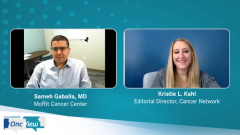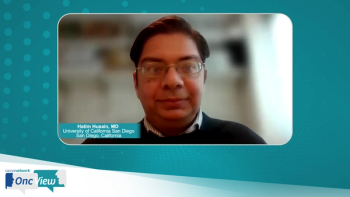
Considerations for Treatment Selection in R/R FL
An expert in follicular lymphoma highlights factors to consider when choosing therapy for first relapse and how this impacts later line treatment, as well as molecular testing and MRD.
Episodes in this series

Kristie L. Kahl: What factors do you consider when choosing treatment for first relapse in relapse or refractory follicular lymphoma?
Sameh Gaballa, MD: Obviously you have to look at a lot of patient-related factors and disease-specific factors. You look at the patient’s age, performance status, comorbidities, and social situation. Do they live 4 hours away, or do they have a caregiver? These are going to be important factors when deciding therapy. If I’m having a patient who’s having a lot of renal impairment, such as clotting issues and whatnot, I may not choose lenalidomide in the second-line setting. I might choose something else. In the third-line setting, if I have a patient who lives 6 hours away, is older, and has no social support, then maybe CAR [chimeric antigen receptor] T-cell therapy is not the best. Those are patient-specific things. There are also disease-specific things. For example, if you have disease with an epidural mass, causing cord compression, these are patients you want to treat with something to control their disease quicker. I might use a slightly more aggressive measures, maybe R-CHOP [rituximab, cyclophosphamide, hydroxydaunorubicin hydrochloride, vincristine, prednisone], just to get a quicker response. For POD24 [progression of follicular lymphoma within 24 months], those who are progressing again within 2 years of primary therapy, we can discuss transplant as an option. I’ll tell them transplant is an option. We used to do a lot of allogeneic transplants in the past. I have not done 1 in 5 or 6 years. With the CAR T approval, we’re going to see less allogeneic transplants.
Kristie L. Kahl: What is the role of molecular testing in the relapse setting?
Sameh Gaballa, MD: Molecular testing is important with the approval for EZH2 inhibitors like tazemetostat. If you are in a situation where you’re trying to consider tazemetostat and you’re interested in identifying your EZH2 mutational status, then you can consider doing mutational testing to see if they’re EZH2-mutant or not. If they’re wild type, molecular testing is not needed, but you still can get responses with tazemetostat. It really depends on what you’re looking for. Maybe you’re looking to use tazemetostat at an earlier line of treatment, and you would want to do that in an EZH2-mutant patient. If it’s a later line of therapy, and you think there are no other good alternatives, you don’t have to do the testing technically. However, if you do choose to test, then yes, this would be the reason to do molecular testing in this setting.
Kristie L. Kahl: Does MRD [minimal residual disease] play a role in the relapsed/refractory setting?
Sameh Gaballa, MD: Not yet, and it’s also not approved, but there’s a lot of research going on in this area. Similar to CLL [chronic lymphocytic leukemia], you could monitor the depth of response with MRD. That is what’s best MRD modality. So right now, no. Maybe in the research setting, yes. We do participate in some of these ongoing projects to look at MRD in the relapse setting. But it’s outside research, and I have not been using it.
Kristie L. Kahl: Through the research, when and how is it being measured, or are we not sure yet?
Sameh Gaballa, MD: There’s a lot of technologies out there but clonoSEQ is 1 of the common ones available. You’re basically looking at the certain clones that you’re following in the immunoglobulin heavy-chain rearrangement area. You have to have a good sample of an initial biopsy so that you look for it, initially identify it, and that’s going to be your ID [identification]. Later on, you will check the blood. There are other things you could do. There’s a CAPP-Seq technology that could identify not just the clones but also mutations like EZH2, which you could monitor. These are the available ones that I’m aware of. There are a lot of others available, but these are the ones that are commonly used.
Kristie L. Kahl: How does the second-line choice after the first relapse impact treatment options in later lines?
Sameh Gaballa, MD: If you have a patient who’s had a very long remission duration from 1 line of therapy, say 3 or 4 years, you can technically rechallenge them with the same regimen, even at the relapse setting. But if you have a shorter remission duration—say you got only 1 year, 1½ years, 2 years—then it probably doesn’t make sense to use the same regimen again. You would probably want to use something else. This is how I see it making the difference.
Transcript edited for clarity.
Newsletter
Stay up to date on recent advances in the multidisciplinary approach to cancer.















































































